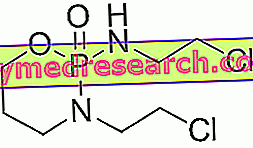Lomustine is an anticancer drug belonging to the class of alkylating agents. It is a very lipophilic drug and is therefore able to cross the blood-brain barrier.

Lomustina - Chemical Structure
Thanks to this characteristic, the primary use of lomustine is that of the treatment of brain tumors.
Indications
For what it uses
Lomustine is indicated in the treatment of:
- Brain tumors;
- Hodgkin's lymphoma;
- Breast cancer;
- Lung cancer;
- Pancreatic cancer;
- Ovarian cancer;
- Melanoma;
- Multiple myeloma;
- Stomach cancer;
- Colon cancer;
- Kidney cancer.
Warnings
Lomustine should be taken carefully following the doctor's instructions, both in terms of the amount of drug to be taken and in the time interval between one dose and another.
If you forget to take a dose, you should not absolutely double your next dose, but you need to inform the oncologist who will decide what to do.
Interactions
Concomitant intake of lomustine and melphalan (an anticancer agent) can cause hemorrhagic enterocolitis in children who - in some cases - have been fatal. The same thing can happen if nalidixic acid (an antibacterial drug) is administered simultaneously with lomustine.
Concomitant intake of lomustine and cimetidine (a drug used for gastric ulcer) may increase the toxicity of the bone marrow.
There may be an increased risk of abnormal bleeding due to changes in platelet function and the onset of thrombocytopenia following concurrent intake of lomustine and drugs such as:
- Aminophylline - ephedrine hydrochloride, a combination of drugs used to treat asthma;
- Methyldigoxin, a cardioactive glucoside with positive inotropic action (increase in cardiac contraction strength), chronotropic and negative dromotropa (respectively, decrease in heart rate and cardiac impulse conduction speed);
- Theophylline and its salts, a drug used for the treatment of asthma and bronchitis thanks to its relaxing action on bronchial smooth muscles.
- Theophylline - carbocysteine, an association of compounds used in expectorant drugs;
- Theophylline - salbutamol, an association of drugs used for the treatment of asthma.
Particular attention should also be paid to the concomitant administration of lomustine and acetylsalicylic acid, since the latter - possessing fluidifying properties for the blood - can increase the risk of bleeding.
You need to tell your doctor if you are taking any type of medication, including over-the-counter medications, herbal and / or homeopathic products.
Side effects
Lomustine-induced side effects may vary depending on the disease being treated, the dose of the drug administered and the patient's condition. Furthermore, there is a great variability in response to individual-to-individual therapy.
Myelosuppression
Lomustine may cause temporary myelosuppression, ie the suppression of bone marrow activity. This suppression causes reduced production of all blood cells. In particular, lomustine causes marked leukopenia and thrombocytopenia.
The leukopenia consists in a decrease in the levels of white blood cells, this increases the susceptibility to the contraction of infections.
Thrombopenia is a reduction in the number of platelets in the bloodstream, which causes bruising and abnormal bleeding with an increased risk of bleeding.
Gastrointestinal disorders
Lomustine may cause nausea, vomiting and diarrhea .
Vomiting usually occurs a few hours after taking the drug and can last up to two or three days. This symptom is controlled with the use of anti-emetic drugs; if - despite the use of these drugs - vomiting persists, it is necessary to inform the doctor.
Diarrhea can be treated with anti-diarrheal drugs and it is necessary to drink a lot to replenish lost fluids.
Weakness
Lomustine treatment can cause generalized fatigue and weakness, so it is important to rest a lot. The drug can also cause lethargy .
Loss of appetite
Lomustine can cause a loss of appetite with consequent loss of body weight .
Reduction of liver function
Lomustine may cause a temporary reduction in liver activity . Therefore, in patients being treated with the drug, liver function must be constantly monitored throughout the duration of the therapy. However, liver activity should normalize at the end of treatment.
Oral cavity disorders
Dry oral cavity, pain and small ulcers may occur during lomustine therapy. To prevent these symptoms, it is important to take plenty of fluids and clean the teeth regularly with a soft toothbrush. In addition, the oncologist can prescribe special mouthwashes or medications to counteract these side effects.
There may also be a temporary taste alteration that will return to normal at the end of treatment.
Hair loss
In reality, this side effect rarely appears during lomustine treatment. Hair can thin out or fall off completely. Even eyelashes and hair can fall, but it is a temporary side effect. Hair, hair and eyelashes will begin to regrow after the treatment is finished.
Pulmonary toxicity
Lomustine therapy can cause both acute pulmonary toxicity and life-threatening delayed pulmonary toxicity. It is a dose-dependent side effect. Patients who took the drug in childhood - or early adolescence - are at greater risk of developing delayed toxicity.
Infertility
Lomustine can affect the ability to conceive.
Other side effects
Lomustine treatment can also cause walking difficulties and changes in vision . These side effects are quite rare, but - if they occur - the oncologist must be informed immediately.
Action mechanism
Lomustine is a nitrosourea belonging to the class of alkylating agents. The drug is capable of decomposing within the cellular aqueous environment; this decomposition gives rise to compounds that possess cytotoxic (cell-toxic) activity. The active compounds that are generated by the decomposition of the drug are capable of interlacing alkyl groups within the double DNA strand. The changes thus induced on the DNA molecule prevent the cell from replicating properly and send it to apoptosis (a mechanism of programmed cell death).
Mode of Use - Posology
Lomustine is available for oral administration; it is found in the form of capsules that can have different colors. The capsules should be taken with plenty of water, preferably on an empty stomach, before going to sleep.
The usual dose is 120-130 mg / m2 of body surface. When administered in combination with other anticancer drugs, the administered dose of lomustine is decreased by 20-50%.
In any case, the dosage must be decided by the oncologist according to the type of tumor to be treated and according to the patient's condition.
Pregnancy and breastfeeding
Since the drug can cause serious damage to the developing fetus, treatment with Lomustine during pregnancy is not recommended.
It is good that both sexes take precautions to avoid any pregnancies for the entire treatment period and for at least six months after the end of the treatment.
Women being treated with Lomustine should not breast-feed.
Contraindications
Lomustine therapy is contraindicated in the following cases:
- Known hypersensitivity to lomustine;
- Pregnant;
- During breastfeeding.



